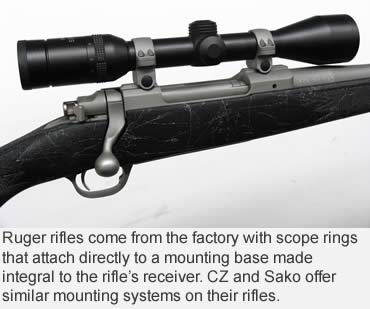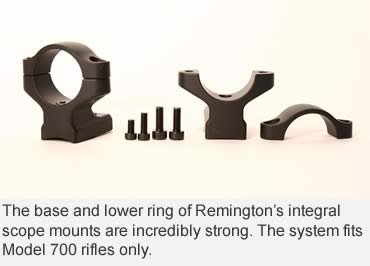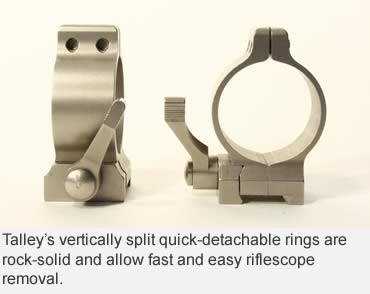“Just any old rings and bases” can be the wrong choice and the weak link that fails at the most inopportune time.
There you stand, rifle in one hand and a riflescope in the other. Since duct tape and baling twine are not options, how shall you bring them together?
Sifting through the myriad riflescope rings and bases on the market seems more trouble than it’s worth.
A friend who runs a local gun shop told me 90 percent of his customers don’t care which rings or bases he uses to mount their riflescopes. They should.
There are a lot of different mounting systems, but from a practical standpoint, only two distinct types: fixed and quick-detachable. The first decision you need to make is which bests suits your needs.
Because I write about rifles and riflescopes for a living, I am constantly swapping scopes for testing. The easier I can make that process, the better I like it. For that reason, I use a lot of quick-detachable systems.
You don’t have to be a gun writer to benefit from the advantages quick detachable rings offer. You may have a rifle you use for groundhogs in the summer and for deer in the fall. If you want to use a different riflescope for each pursuit, quick-detach rings make sense.
They’re also the way to go if you have a rifle equipped with open sights and plan on switching between the sights and the scope as need dictates.
I hunted black bears in Alberta last spring with Marlin’s new 1895 SBL. This lever-action gun comes with an XS Sights Lever Rail for scope mounting, but is also equipped with an XS aperture rear sight. I had a Swarovski Z6 extended eye relief scope mounted in quick-detachable rings, and each evening as the light began to fade, I switched from open sights to the scope.
 For those who prefer open sights as a backup to a scope, Talley has a removable rear aperture sight that attaches to the bases used by their quick-detachable rings. Jim Brockman of Brockman’s Custom Rifles has modified a Talley base with an incredibly cool aperture sight that pops up when you remove the scope. I’ve tested and hunted with both, and they’re bulletproof designs.
For those who prefer open sights as a backup to a scope, Talley has a removable rear aperture sight that attaches to the bases used by their quick-detachable rings. Jim Brockman of Brockman’s Custom Rifles has modified a Talley base with an incredibly cool aperture sight that pops up when you remove the scope. I’ve tested and hunted with both, and they’re bulletproof designs.
Another advantage of quick-detachable rings is they afford you the option of carrying a second pre-zeroed scope with you. This is no big deal locally, but on remote wilderness hunts or hunts in Africa and other countries, it could save the trip from disaster should your riflescope break.
You might have also recently purchased an expensive scope like the Swarovski Z6 or a specialty scope like the Nikon Coyote Special. It would be a shame to use either on only one rifle or to get a screwdriver every time you wanted to switch it. Quick-detachable rings simplify this, allowing you to get your money’s worth out of expensive optics.
Most rimfire rifles have a rail integral to the receiver, grooved to accept ?-inch rimfire scope rings. With the exception of those and the detachable rings that come standard with all Ruger and CZ centerfire rifles, most mounting systems are three-piece units, meaning; you have two ring halves and a base.
Sako rifles have an integral base, but their Optilock mounting system is still a three-piece system.
With some fixed mounting systems like the Talley Lightweight and Remington’s new Integral system, the base is joined to the bottom ring, making a two-piece system. The advantages of two-piece systems are fewer components and more rigid construction.
 Fixed scope mounts provide a cleaner look, generally weigh less and don’t cost as much as quick-detachable rings. And Some hunters just don’t trust detachable systems. I use fixed systems on several of my rifles, the ones dedicated to a certain pursuit.
Fixed scope mounts provide a cleaner look, generally weigh less and don’t cost as much as quick-detachable rings. And Some hunters just don’t trust detachable systems. I use fixed systems on several of my rifles, the ones dedicated to a certain pursuit.
Leupold’s Standard mount is a fixed-mount system that incorporates windage adjustment into the rear scope base. This is made possible by opposing screws that engage grooves in the bottom half of the rear ring. If your scope does not have enough horizontal adjustment for zeroing, this will cure that problem.
Also keep in mind that with most scopes, the closer the reticle is to the centerline, the better the scope will perform.
Leupold and Burris both make the standard and a dual dovetail mounting system. Burris calls their standard base the Universal. Leupold standard rings and Burris Universal rings are interchangeable, as are their dual dovetail rings. Weaver offers Grand Slam rings to fit both of these bases.
Another approach to point-of-aim adjustment with the mounting system is the Burris Signature Rings with the Pos-Align Offset Inserts. These rings are made slightly larger than the scope tube, but have synthetic inserts that, depending on size, allow you to move the point of impact as much as 30 inches in any direction at 100 yards.
 Some will argue that fixed-mount systems are more rugged and less prone to a shift in point of impact. That might be true, but it has been my experience that quick-detachable systems hold zero incredibly well as long as you keep the levers tight. Some also do an incredible job of returning to zero after they’ve been removed.
Some will argue that fixed-mount systems are more rugged and less prone to a shift in point of impact. That might be true, but it has been my experience that quick-detachable systems hold zero incredibly well as long as you keep the levers tight. Some also do an incredible job of returning to zero after they’ve been removed.
Custom rifle builder Charlie Sisk does not use anything but vertically split Talley steel, screw-lock or quick-detachable rings on the hard-kicking rifles he builds. Melvin Forbes of New Ultra Light Arms ships a set of Talley Lightweight Rings with every rifle he makes. Both work exceptionally well.
Whether you choose a fixed or detachable system, you must decide between rings that are split vertically or horizontally.
Vertically split rings are a bit harder to install, but offer the advantage that both ring halves engage the base. All DuraSight, Warne and Talley quick-detachable and screw-lock rings are vertically split.
Some bases will work with rings from different manufacturers. Weaver bases fit a the widest variety of rings on the market. Both aluminum and steel bases are offered, as well as several horizontally split ring designs that mate with the bases.
Any ring that works on a Weaver base will also work on a Picatinny rail. The Picatinny rail is found on the receiver of all AR-style rifles without a fixed carry handle. However, the cross slots on Weaver bases are not as wide as the slots on a Picatinny rail.
To get the best protection against ring shift during recoil when using rings designed for a Weaver base on a Picatinny rail, position the front ring so the recoil lug is as far forward in the slot as possible. Position the lug on the rear ring as far to the rear as possible as well.
Some ring-and-base systems are not interchangeable. Leupold’s QR system consists of a base with a lever that turns a cam-lock into a recession on a stud protruding from the bottom ring. Only Leupold QR rings will fit Leupold QR bases. Though completely different in design, Ruger and CZ rings will not fit other firearms or bases, and Talley’s steel rings and bases are not interchangeable with any other system.
 Something else to consider is the one- or two-piece base. A one-piece base or rail still uses the same mounting holes and screws, but because it is one piece, theoretically it’s stronger. One-piece bases can cover a portion of the ejection port. I’ve never found this to infringe on reliability but it can make clearing a jam or unloading difficult, especially if your rifle has a blind box magazine.
Something else to consider is the one- or two-piece base. A one-piece base or rail still uses the same mounting holes and screws, but because it is one piece, theoretically it’s stronger. One-piece bases can cover a portion of the ejection port. I’ve never found this to infringe on reliability but it can make clearing a jam or unloading difficult, especially if your rifle has a blind box magazine.
See-through rings are not as popular as they used to be. They provide visual access to the open sights, but don’t expect to see much. Often, the objective bell of the scope protrudes so far down, you can’t see well enough to safely or quickly place an accurate shot.
Also, the higher you mount a scope above a rifle barrel, the less force that’s needed to knock the scope out of zero, and the higher you will have to raise your head above the stock to look through the scope.
Sometimes, especially with AR-style rifles, you’ll need to get the scope higher than traditional mounts allow. This is because AR stocks are in line with the barrel. Riser blocks are what’s needed, and they attach directly to the Picatinny rail. Remington offers riser blocks camouflaged to match their R-15 and R-25 rifles.
Savvy hunters will take the time to research mounting systems and choose the one that compliments their rifle and the work they have planned for it.
Sources
Brockman’s Custom Rifles
Burris
DuraSight
Leupold
Nikon
Remington
Talley
Warne
Weaver
XS
This article was published in the October 2010 edition of Buckmasters GunHunter Magazine. Subscribe today to have GunHunter delivered to your home.